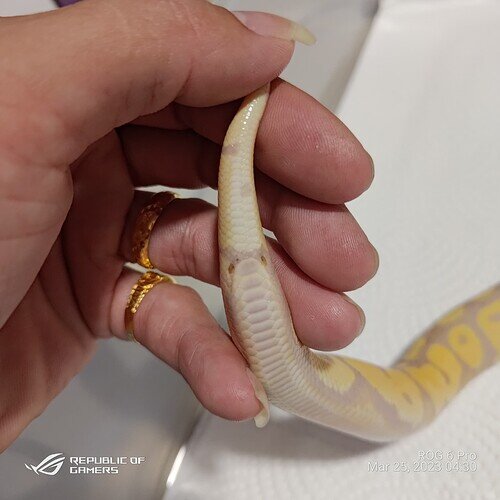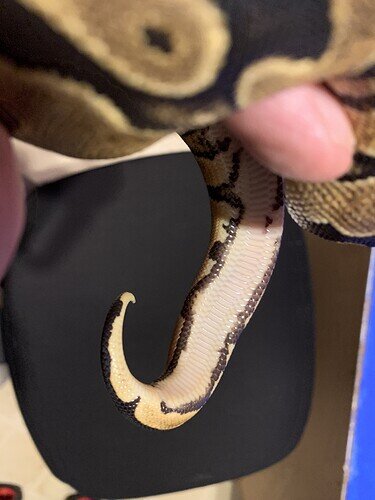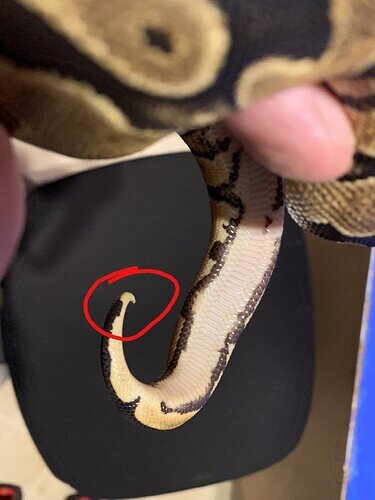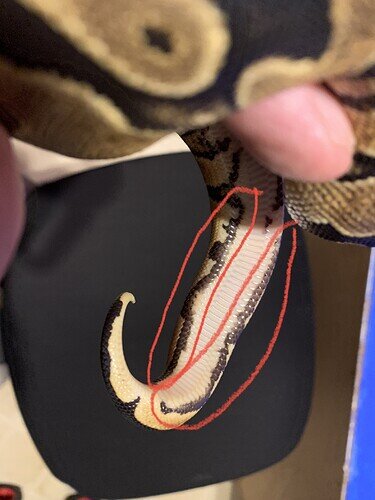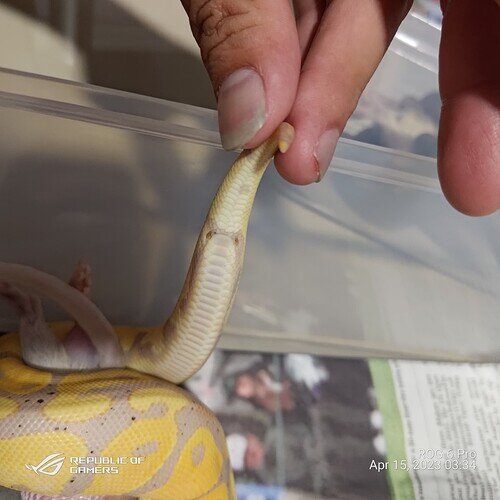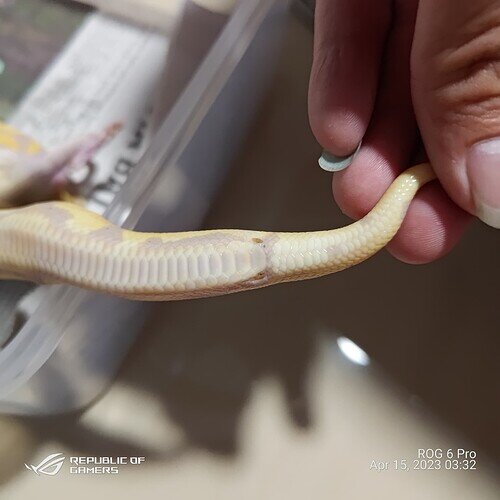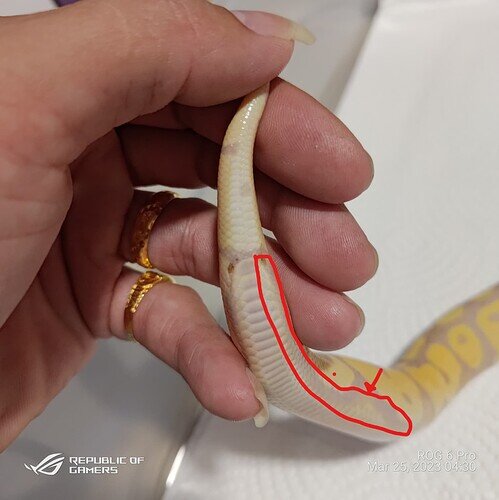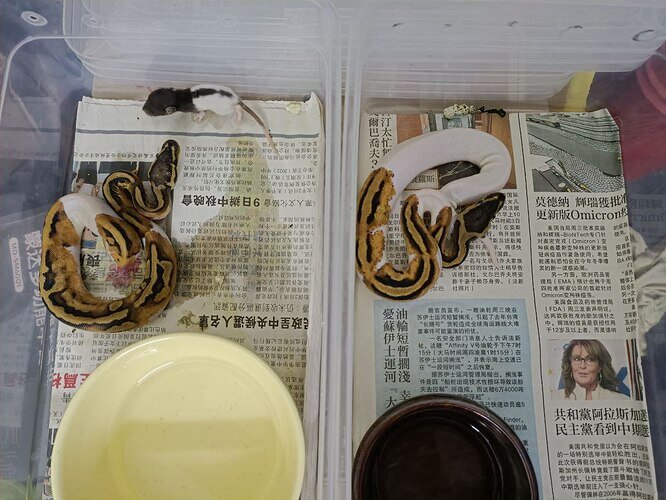I previous I bought a banana het pied… however I still can’t google much on a banana het pied morph… I bought from a breeder and he told me pied is ID by the tail end. But I don’t see any difference
There are typically some markers for het pied, but the biggest thing to go off of would be the pairing of the parents. Was one of the parents a pied? Then all babies are het pied. There is also genetic testing now as well, that can test for the presence of het pied in ball pythons.
Pied is currently listed as a recessive, but with the amount of markers present that people can use to identify them, it theoretically shouldn’t be a recessive.
@nswilkerson1 is correct, the pairing of the parents(if one was a visual)or genetic testing are the only 100% ways to know for sure. That being said, there can be some het. Influence and markers on some animals. Just remember it doesn’t always guarantee it as a definitive heterozygous animal. Here are the train tracks of my het red het pied. Looks like someone sharpied a black line on both sides of the lower belly. With banana this is going to be difficult to tell, since there is no real black on the snake. Excuse the bad pic he didn’t want to sit still! Good luck with yours.
Since Pied is a recessive gene, typically a snake needs to be carrying 2 copies of the gene to show as ‘pied’.
What people have called ‘markers’ most often tend to be polymorphic traits that happen in some recessive animals. They’re not a guarantee. the tail markers are usually identified by the borders of the white belly having darker train track looking marks running parallel on each side…but other genes can have the same markings, like Orange Dream for example.
The only way to ID het pied for sure is to contact the breeder and verify that one parent was indeed a visual pied, have the genetic testing done, or breed them to a pied and hatch out pied babies.
Also…
If you DO breed this male to your cinnamon GHI, not all of the babies will inherit the gene for pied. Only 1/2 of them will so they would be a mixed bag of any combo of banana, ghi or cinnamon or even just a plain normal but they would all be called 50% het pied.
This is the part to id on the tip tail???
No sorry for the confusion, it’s just the lower belly area of the snake on both sides, with the belly scales it kinda looks like “train tracks” with 2 solid black lines on either side of the belly and the scales going in between them. I will markup my pic. It actually isn’t the best pic or representation of the het pied tracks, I am sure you can find better images on here.
Het pieds can have tracks OR ringers.
But many have no markers at all.
What was parents?
I think this should be the key takeaway here. Markers aren’t always present, and really should only be considered if you’re looking at an animal that is a known Het for pied.
If one of the parents was indeed pied, then the baby will be 100% het pied.
In 20 years of producing Pieds and hets, I’ve seen only one animal that did not have textbook markers. I’ve hatched thousands of hets and Pieds over the years.
One thing almost everyone fails to mention is yellow smudging on the belly of hets. It’s another marker that is easier to identify as hatchlings and juveniles, and tends to go unnoticed in adults due to color change.
Markers can be a way to help identify a het pied animal among pairings that produce possible het pieds but are not a sure thing.
I have proved out one possible het pied as 100% het that had the “tracks” that lead to the vent (example pictured by Bane).
From what I can tell your banana has those tracks. If it’s from a pairing that yielded possible het pieds I’d say it’s reasonable to assume it is probably het.
More information from Justin here:
Assuming that there was Pied going into the pairing, I’d say the look of your Banana backs up what the breeder is saying.
You’ve got a long lavender (normally black) track running a long way down under the pattern, also where I show the arrow there’s a faint ringer mark.
None of the het Pied markers are foolproof, but unless there’s a reason to think the breeder is shady I think you can rest easy she will prove het Pied. The other option is to pay $65 to have her shed tested to pretty conclusively prove it (probably not worth it imo)
A little harder to see in that color scheme but looks promising for being het pied. Best of luck!
I have a shed in for testing for hypo and pied where the pos pos het monsoon girl doesn’t look het pied at all. Hopefully I’m pleasantly surprised and she is the rare exception but I have found the markers to be pretty reliable so am not holding out much hope. I do wonder if some other pattern mutations (het monsoon?) might interfere with the normal het pied expression.
Thanks for the highlight here. Actually right now the seller recommend me to get a banana pastel pied female…
